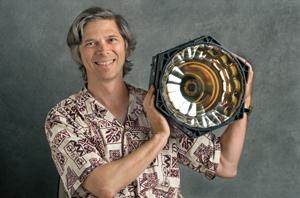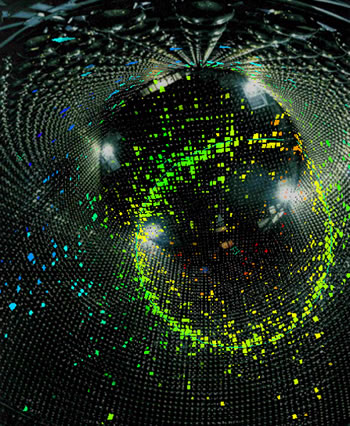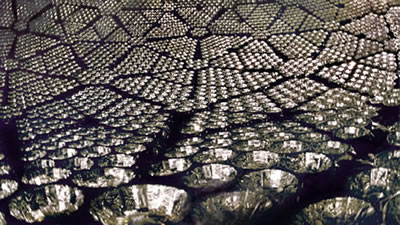Nature’s Unending Surprises: the Neutrino
The first of two articles on neutrino science at Berkeley Lab
By Paul Preuss
 Neutrino hunter Kevin Lesko of Berkeley Lab’s Nuclear Sciences Division holds a photomultiplier tube like those used in solving the missing solar neutrino mystery. (Photo by Roy Kaltschmidt)
Neutrino hunter Kevin Lesko of Berkeley Lab’s Nuclear Sciences Division holds a photomultiplier tube like those used in solving the missing solar neutrino mystery. (Photo by Roy Kaltschmidt)
The ancient Greek word for nature was physikos, and “Physika!” still means “Naturally!” in Greek today. While it’s true that physics has given us a lot of technological gadgets, most physicists are after bigger game: like the ancients, they’re trying to figure out how nature works.
One measure of progress is ignorance. There’s a lot more we don’t know today than we even suspected we didn’t know when Einstein was born 130 years ago this month. Dark matter, for example, discovered in the 1930s, might take several possible forms, but none has yet been found. And the nature of dark energy, discovered in the 1990s by the Supernova Cosmology Project based at Berkeley Lab and soon confirmed by the High-Z Supernova Search Team, is still a profound mystery. Together, dark matter and dark energy make up three-quarters of the universe. A lot of the rest is filled with a ubiquitous particle of “ordinary” matter called the neutrino.
Not really that ordinary, the neutrino is still surprising us 80 years after its existence was first suspected. We now know that copious amounts of neutrinos were created in the big bang and are still being created in vast numbers in the hearts of stars, in supernovae, and other sources including accelerators and nuclear reactors here on Earth. There are more neutrinos in the universe than any other kind of particle except photons – light itself. We walk around drenched in neutrinos, which fall right through us by the trillions every second, as if we were transparent, which as far as neutrinos are concerned we might as well be.
How did we ever stumble upon these ghostlike particles? Not by observation but by induction. In the late 1920s, radioactive beta (electron) decays were among the most puzzling phenomena physicists had to grapple with, because the energy of the electrons emitted in these decays didn’t equal the energy lost by the decaying nuclei. So intractable was the problem that Neils Bohr, never afraid to jettison baby with bathwater, suggested that maybe the principle of conservation of energy just didn’t apply to radioactive decay.
Wolfgang Pauli was more stubborn and finally proposed what he called a “desperate remedy”: there must be an undetected extra particle that carries off the missing energy in beta decays, a particle having no electrical charge and no more mass than the electron. In Italy, where by 1933 Enrico Fermi had worked out a consistent theory for such a particle, the word for “little neutral one” is neutrino.
Fermi’s invisible neutral particle was somewhat different than Pauli’s – it had no mass at all and consequently moved at the speed of light. Fermi invoked a whole new force of nature (in addition to gravity and electromagnetism), the weak force, to explain why neutrinos only weakly interact with matter – so weakly that an average neutrino might pass through 50 light-years of lead without hitting anything.
Thus the massless neutrino entered a growing set of physicists’ well-founded assumptions about the way the world works; many years later these would come to be known as the Standard Model of Particles and Interactions.
Neutrinos weren’t actually detected until the 1950s, when Clyde Cowan and Frederick Reines tracked them down in the radiation from a nuclear reactor. The equations describing these kinds of nuclear processes made more sense if Cowan and Reines’s neutrinos (and Fermi’s) were thought of as antiparticles of neutrinos, antineutrinos.
Then the surprises began in earnest. Before long it was apparent that neutrinos and antineutrinos come in more than one “flavor”: in addition to those associated with electrons, others were associated with the electron’s massive cousins, muons and tau particles.
 Underground neutrino experiments have established that neutrinos oscillate among various “flavors” (electron neutrino, muon neutrino, and tau neutrino) and therefore must have at least a tiny mass, different for each flavor. (Image copyright Kamioka Observatory, Institute for Cosmic Ray Research, The University of Tokyo)
Underground neutrino experiments have established that neutrinos oscillate among various “flavors” (electron neutrino, muon neutrino, and tau neutrino) and therefore must have at least a tiny mass, different for each flavor. (Image copyright Kamioka Observatory, Institute for Cosmic Ray Research, The University of Tokyo)
The biggest surprise came in the mid-1960s, when experiments made by Ray Davis deep in the Homestake Mine in South Dakota – a place we’ll hear more about later – detected only one-third the number of neutrinos that theorist John Bahcall had predicted it should, from those created in nuclear reactions in the sun. Either we were profoundly ignorant about what really goes on inside the sun, or we had a lot to learn about neutrinos.
The most intriguing explanation for the missing solar neutrinos was that, while the sun creates as many electron neutrinos as it should, on the way to the detector they change into their cousins, muon and tau neutrinos, and possibly back again. Muon and tau neutrino flavors were invisible to Davis’s detector, which only snagged electron neutrinos when they induced chemical changes inside a tank filled with 600 metric tons of dry-cleaning fluid. To test the “neutrino oscillation” hypothesis, new kinds of detectors were needed.
Berkeley Lab scientists now entered the experimental picture in a big way. The most direct and ambitious experiment to measure solar neutrinos was proposed in the 1980s: the Sudbury Neutrino Observatory, or SNO. Built by a collaboration of institutions in Canada, the U.S., and the U.K., SNO finally began operating in 1999. Like the Davis experiment, SNO was installed deep in a mine to shield its detector from ubiquitous cosmic rays. At its heart is a huge acrylic vessel, 12 meters (over 39 feet) in diameter, filled with a thousand metric tons of heavy water and itself sunk in a pool of pure, ordinary water 30 meters deep. Heavy water, unlike dry-cleaning fluid, can be studied to reveal all three flavors of neutrino.
SNO’s acrylic vessel is surrounded by 10,000 photomultiplier tubes that track the faint flashes of blue light made when approximately 10 neutrinos a day – out of the five-and-half million per square centimeter per second that enter the huge detector – collide with heavy water molecules inside. The geodesic support structure for these myriad photomultipliers was designed and built at Berkeley Lab under the direction of Kevin Lesko of the Nuclear Sciences Division.
In 2001, analysis of data from SNO, supported by other experiments, confirmed that the sun does indeed produce the predicted number of electron neutrinos and that these do indeed transform themselves into muon and tau neutrinos before they reach detectors on Earth.
 Berkeley Lab scientists and engineers designed and constructed the geodesic support structure for SNO’s array of 10,000 photomultiplier tubes. (Photo by Roy Kaltschmidt)
Berkeley Lab scientists and engineers designed and constructed the geodesic support structure for SNO’s array of 10,000 photomultiplier tubes. (Photo by Roy Kaltschmidt)
Our ignorance instantly multiplied. Gone was the Standard Model’s massless neutrino traveling at the speed of light. In order to exchange identities, neutrinos have to have mass, if only a little, with a different mass for each flavor. But how much do neutrinos weigh? Which flavor is the heaviest?
Meanwhile theorists had come up with even more abstruse neutrino mysteries, involving such questions as whether the neutrino is its own antiparticle, whether there is a fourth flavor of neutrinos that is “sterile” (doesn’t even interact via the weak force), what role neutrinos played in the creation of matter and antimatter at the dawn of the universe, and how neutrinos might be used to peer into the heart of the hidden events of the cosmos.
Berkeley Lab scientists are playing leading roles in a range of neutrino studies situated around the world that are intended to answer these questions. In the next part of this article we’ll hear about experiments called KamLAND (Japan), Daya Bay (China), IceCube (the South Pole), and yes, a deep underground laboratory named DUSEL in the Homestake Mine in South Dakota. Watch for part II in mid-March, 2009, as part of the Year of Science.
Additional information
- For Wikipedia’s overview of neutrinos, visit http://en.wikipedia.org/wiki/Neutrino
- For Wikipedia’s discussion of beta decay, visit http://en.wikipedia.org/wiki/Beta_decay
- For Wolfgang Pauli’s “desperate remedy,” see http://www.pp.rhul.ac.uk/~ptd/TEACHING/PH2510/pauli-letter.html
- For more on the Sudbury Neutrino Observator, visit http://www.sno.phy.queensu.ca/
- For more on Berkeley Lab’s participation in SNO, see http://www.lbl.gov/Science-Articles/Research-Review/Highlights/2000/stories/astrophysics/sno.html


